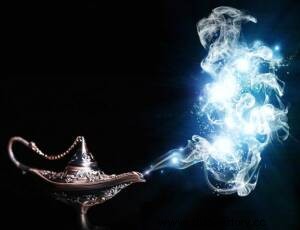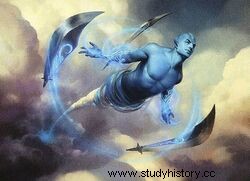Folk tales and urban legends, the two words that always take us back to the days of childhood. Regardless of language or geographical location, we have all at one time or another heard stories of various urban legends in our lives. From fairies to eerie and haunting stories, we have heard stories of almost every possible scary creature. They are whispered around the campfires and passed down from generation to generation. These are the stories we all love to hear and be afraid of. But what are these urban legends and where did they start?
The Origins of Urban Legends
Urban legends, referred to by folklorists as contemporary legends, are fictional stories that are claimed to be true. These urban legends began to appear in print around 1968, but these stories existed as an oral tradition long before they came into print. Myths and legends throughout history often contain an underlying warning about a potential danger to avoid.
Elements of Urban Legends
Usually, the urban legends are framed as complete stories with plots and characters. The compelling appeal of a typical urban legend is its elements of mystery, fear, dread or humor. Often they act as warning stories. Some urban legends are moral stories that depict someone, usually a child, behaving in an unpleasant way, only to end up in trouble, injured or dead. These stories generally ignite the element of shock and fear in readers, making them memorable to readers. These shock values are found in almost every form of urban legend, and these values make these stories effective. Sometimes these stories include supernatural or paranormal activities to create fear and excitement in the audience. Their motifs usually take the form of bloodthirsty night creatures, scary enchanters, monsters or vengeful ghouls.
Psychology and urban legends
Social scientists have begun to draw on urban legends to help explain complex socio-psychological perceptions, such as attitudes toward crime, childcare, fast food, and other "family" choices. Psychologically, urban legends are a way for us to understand the world and deal with threats in a safe environment. From the believer's perspective, these myths serve as evidence and reinforce existing beliefs. This is important because they help validate a person's worldview and help legitimize fear as real and genuine.
Urban legends in the Arab context
Folk tales are a popular form of oral literature in Arab countries. The UAE (United Arab Emirates) has long been the playground of the wealthy and powerful. But beneath the impressive architectural wonders, there are stories that cast a shadow on the city's dazzling light. Of jinn and fairy tales, this powerhouse has many legends who are known for their rich, diverse and colorful legends. These stories are given orally from generation to generation, and are known to be pure myths and have taken on the role of common fairy tales among Arabs. Many others still have a hint that they actually took place, which makes these myths and legends increasingly exciting.
The Legend of Aladdins Wonder Lamp
One of the most famous folklore in Arabia, the legend of Aladdin, and his wonder lamp can be found on the pages of the book One Thousand and One Nights. The famous story beautifully captures the imagination of children and adults from all over the world. The poor story is about the life of a young man named Aladdin who embarks on a series of adventures after being tricked by an evil wizard. Aladdin also comes in contact with a magical creature called Jinn or (Anglicized Genie) who helps him win the love of a princess.
Djinn / Genie
Djinns are believed to be powerful, invisible beings, capable of owning humans and even inflicting suffering on them. Stories of human encounters with djinn are very common cultures and history. It is generally believed that these transparent and invisible beings have enormous powers and are not predetermined by the laws of physics such as matter, weight, time and place. Unlike humans, they cross the invisible and the manifested worlds and move across dimensional boundaries. They can also travel anywhere in an instant and transform into the form of other beings such as cats, dogs, birds, snakes or even humans.
In popular Western culture, jinns are often seen as spirits trapped inside an old lamp by the evil wizard, as when rubbed, a jinn appears outside them. It is traditionally said that the great and wise King Solomon closed badly behaved Djinn in lead-cork bottles and threw them into the sea. This description comes from the Western translation of the book One Thousand and One Nights. When someone rubs the lamp three times, Jinnien will appear inside and obey the one who set it free by giving three wishes. However, in the original doctrine, jinns do not exist inside the brass lamps, nor do they fulfill desires, contrary to popular belief.
Mythical creation of the Bahamut
-
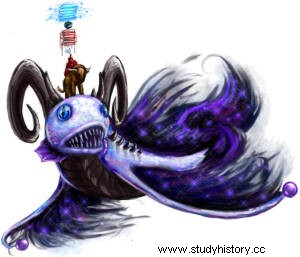
- Bahamut is a giant and monstrous fish located in the deep sea. Its power lies in its enormous size and strength. This mythical creature was believed by ancient Arabs to keep the earth afloat. In this myth, the giant fish carries a giant bull, called Kujata. On the ridge of Kujata there is a mountain made of ruby. At the top of the ruby mountain, an angel holds the seven stages of the earth. Beneath the cosmos, surrounded by water and fog, swims the Bahamut, a fish of incomprehensible dimensions that carries the world on its back. No human eye can see the Bahamut, but without him all human beings would have been cast into the darkness. In addition to its brutal strength, Bahamut also has the ability to confuse human vision. He is so great that even the mere sight of him would drive a man out of his senses.
A variant of the Bahamut appears in Hebrew legend, under the name Behemoth. A behemoth usually takes the form of a hippopotamus, elephant or ox. He lives on land and is known for his huge appetite. Sometimes he is cast out as Satan's servant and is said to preside over gluttonous banquets in hell.
Monster of Nasnas
In Arabic folklore, Nasnas is a monster believed to be the offspring of a demon called a Shiqq and a human. This monster is said to have the power to make people meatless by just touching them. A Nasnas is a half human, who has a half head, a half body, an arm, a leg, and jumps around with a lot of agility. The Nasnas are mentioned in Gustave Flaubert's The Temptation of Saint Anthony.
Mythical sea creature
-

- In Arabic folklore, there is a mythical sea animal called Dandan that lives in the deep blue waters of the sea. Dandan is a large monstrous fish in the sea and is able to swallow a ship and its entire crew in one gulp. The description of this creature can be found on the pages of the book One Thousand and One Nights (or Arabian Nights). It is shown in the story "Abdullah the Fisherman and Abdullah the Merman", where the fisherman tells the fisherman that Dandan is the biggest fish in the sea and is the fishermen's enemy.
Mythical Bird of Roc
Roc is a huge mythical creature in Arabic mythology. Many sailors, fishermen and explorers have said that they saw this magical creature during their adventure in the sea. Roc can be compared to the western mythical creature Phoenix and the Indian mythical creature Garuda. The episode of Roc encounter can be found in the story collection A Thousand and One Nights, the stories of Abd al-Rahman and the sailor Sinbad.
Snake Monster
Falak is the giant snake mentioned in One Thousand and One Nights. He lives under Bahamut, the giant fish, which carries with an ox and an angel, the rest of the universe, including six hell, earth and heaven. Falak himself lives in the seventh hell below everything else. It is believed that this creature is so powerful and that only its fear of God's greater power prevents it from swallowing the entire creation above.
Almiraj- The mythical beast
In Arabic folklore, Almiraj is a mythical beast who lives on a mythical island called Jazirah al-Tennyn (Sea-Serpent Island). This island is said to be in the deep confines of the Indian Ocean. It is said that this magical creature may take the form of a rabbit with a unicorn-like horn or horns. According to legend, the beast was a gift given to Alexander the Great by the inhabitants of the island after he killed a large dragon that had eaten of the livestock of the people there.
The mythical creature of Shadhavar
Shadhavar was a mythical Arab creature in the Middle Ages. Shavadhar is believed to be a unicorn-like creature that has one horn with 42 hollow branches. As the wind blows through these many branches, it produces a pleasant sound that fascinates the animals and makes them sit and listen to music. When played on the one hand, they produce a cheerful sound, and on the other, the music is so sad that it makes people cry. This creature is believed to have lived in the city of Byzantium.
Mythical creation of Shahmaran
-
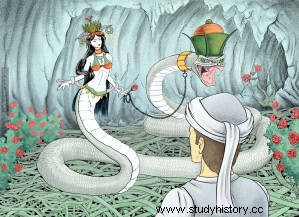
- Shahmaran © Google
Shahmaran is a mythical creature, half female and half snake, found with different variations in the folklore of Iran, Anatolia, the Armenian highlands, Iraq and the Kurds. In Arabic folklore, the first person she meets is a young man named Camasb. Camasb gets stuck in a cave after trying to steal honey with a few friends; his friends leave him. Stuck alone in the cave, he decides to explore it and finds a passage to a chamber that looks like a mysterious and beautiful garden. The cave served as a shelter for Shahmaran, who lived harmoniously with thousands of off-white-colored snakes. At this point, Shahmaran and Camasb fall in love and start living in the cave chamber. Shahmaran teaches him about medicines and medicinal herbs. In the end, Camasb misses living above ground and wants to leave, but he assures Shahmaran that he will not reveal her hiding place. Many years pass and one day the king of the city, Tarsus, falls ill. The visor suggests that he demand that Shahmaran's flesh treat the king and save him. Camasb reveals Shahmaran's hiding place to the city's inhabitants, and according to legend, Shahmaran says:"Blanch me in a platter, give my extract to the vizier and feed my flesh to the sultan." It is believed that Shahmaran was brought to the city and killed in a bath called "Sahmaran Bath." Her flesh was given to the king and his life, and the vizier dies after eating the extract. Camasb drinks Shahmaran's water and becomes a doctor by gaining Shahmaran's wisdom. As with all folklore, as time went on, many variations were added to this story.
Treacherous spirit of Arabic folklore
Sila (literally:"Hag" or "treacherous spirit of unchanging form") is a supernatural creature in Arabic folklore. They are the most malicious spirits in the djinn class, and they are commissioned to work for the djinn or ghouls in Arabic folklore. They are described as talented shape changers, often appearing in human form and especially as a woman. Despite their impressive shape-shifting abilities, they can be detected by their hybrid appearance of animals.
It is said that the Si'latans live in the desolate parts of the desert where they lead the travelers and nomads astray, leading them to their death. They are also said to seduce and marry men or even give birth to a child from a human-jinn relationship. Silas are usually female and in line with intercourse, but not all are succubi or females.
Sands Atlantis
The lost city of Atlantis of the Sands, now shrouded in myths and legends, was supposedly an ancient city in Arabia that was destroyed and buried under sand by a series of natural disasters caused by angry gods. Many explorers continue to believe this story and search for this lost city, and some believe it is located somewhere in the southern deserts of present-day Saudi Arabia.
The blue-eyed woman-
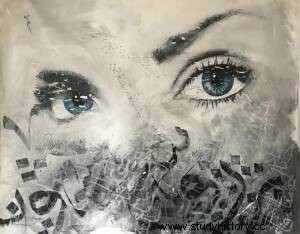
- Blue-eyed woman © Google
In Arabic mythology, Zarqa 'Al-Yamama was a powerful woman with incredible powers and magic. Legend has it that she had radiant blue eyes that helped her predict the future and predict events. Zarqa's tribe relied on her powers to detect enemies and defend their land, as she was believed to have the ability to see riders from a week's distance. Hoping to escape Zarqa's gaze, the enemies decided to hide behind the trees they were carrying. Zarqa noticed what was going on and warned her trunk that the trees were moving towards them and that they were hiding soldiers behind them. To her dismay, members of her tribe thought she was going crazy and chose to ignore her warning. But in the end, the enemies overtook them and destroyed the tribe of Zarqa and crucified Zarqa, tearing out her eyes.
The monster from Qutrub
In Arabic folklore, Qutrub is a type of jinn or demon, which has a look similar to a werewolf. Qutrub is often depicted as similar to the Western concept of a ghoul, as it is written to be the haunt of cemeteries and consuming corpses. Qutrub also appears as a monster in the role-playing game Final Fantasy XI.
Urban legends in modern concept
Urban legends are one of the most relevant and exciting forms of modern storytelling. These stories are important because they are reflections of society's perceptions, concerns and interests. One could even say that urban legends are in many ways a phenomenon. Why do so many people believe in things without any real proof that they are true? In fact, we love to believe in improbable, curious, and intimidating things, whether they make sense or not. Urban legends are driven by an individual's imagination and creativity. Apart from strengthening and dueling creativity, urban legends also serve as a way to convey a message to the young generation. For example, the moral "appearance may be misleading" is promoted through the character Sila. In the same way, the story of Zarqa and Shahmaran shows selflessness and provides help to those who need it. Also, everyone likes to share crazy and interesting stories and rumors - today's culture loves gossip, and we have practical ways to share it. Thus, urban legends reflect the habits of our culture and are driven by our everyday practices and curiosities.



